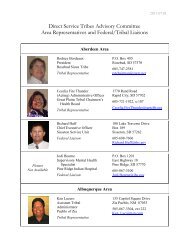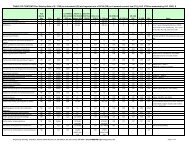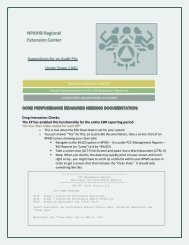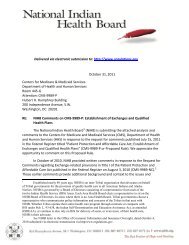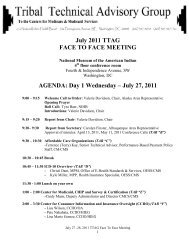âHealth Insurance Premium Tax Creditâ (IRS REG-131491-10)
âHealth Insurance Premium Tax Creditâ (IRS REG-131491-10)
âHealth Insurance Premium Tax Creditâ (IRS REG-131491-10)
- No tags were found...
You also want an ePaper? Increase the reach of your titles
YUMPU automatically turns print PDFs into web optimized ePapers that Google loves.
NIHB Supplemental Submission - Definition of IndianLimiting the definition of ―Indian‖ to members of Federally-recognized Tribesdisregards these individuals outright in violation of the statutes‘ plain language andunderlying directives. It is critical that CMS retract its reliance on Federally-recognizedtribal membership, lest it essentially write Alaska Natives out of the scope of the law.3.1.2 Other Organized Groups and Communities – California Indians.As a result of a series of destructive Federal actions and policies specificallypertaining to California Indians, 29 thousands of ―California Indians‖ are not members ofFederally-recognized Indian Tribes. They do continue to be ―recognized as eligible forspecial programs and services provided by the United States for Indians because of theirstatus as Indians,‖ and therefore to fall within the definitions of Indian under the ACA. 30 Forexample, in 25 U.S.C. § 1679, 31 Congress mandated the provision of health care to a varietyof California Indians. The Indians to be served include:(1) Any member of a federally recognized Indian tribe. 32(2) Any descendant of an Indian who was residing inCalifornia on June 1, 1852, but only if such descendant--(A) is living in California,(B) is a member of the Indian community served by alocal program of the Service; and(C) is regarded as an Indian by the community in whichsuch descendant lives. 33(3) Any Indian who holds trust interests in public domain,national forest, or Indian reservation allotments in California. 34(4) Any Indian in California who is listed on the plans fordistribution of the assets of California rancherias and reservations29We note that in the reference to the IHCIA definition of Indian all of § 4 of the IHCIA isreferenced. Contained within § 4 is not only a definition of ―Indian,‖ but also of ―California Indian.‖See, § 4(3). Had Congress intended to exclude these ―Indians,‖ it could easily have done so byreferencing only § 4(13). It did not.30NIHB is grateful to the California Rural Indian Health Board (―CRIHB‖) for sharing itsanalysis of the status of California Indians and encourages HHS and other Federal agencies to considerCRIHB‘s more detailed comments on the status of California Indians.3125 U.S.C. § 1679 is § 809 of the IHCIA, as amended, and is referred to in the definition of―California Indian‖ at § 4(3).32These Indians are, by definition, tribal members, and their eligibility therefore requires nofurther elaboration.33Regardless of their formal enrollment status, all of these descendants are by definition part ofthe Indian ―community‖ and are eligible for the ―special . . . services provided by the United States toIndians‖ because of their status as Indians. They therefore meet the portion of the definitional test thatrequires them to being members of a ―tribe. . . or other organized group or community.‖34Each of these Indians has an interest in land held in trust by the United States for thatindividual. As such, they are receiving the benefit of services provided by the U.S. because of theirstatus as Indians. If not, the land could not be held in trust and administered by the U.S. for thatindividual Indian‘s benefit.National Indian Health Board Page 8 of 24 October 31, 2011




